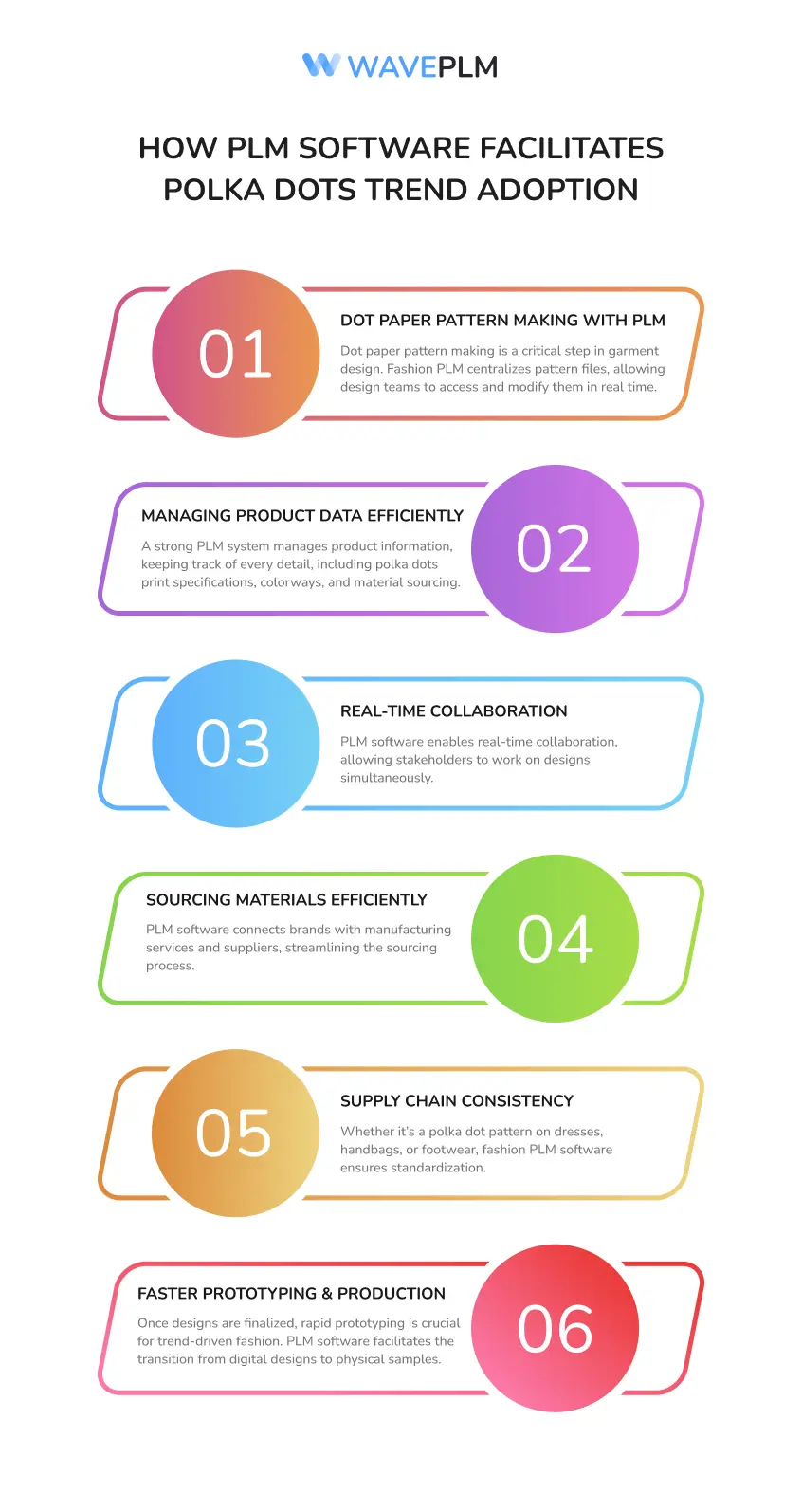
Polka dots are back in the spotlight for 2025. The timeless pattern, known for its playful appeal, is making waves across the fashion industry. From polka dot dresses to polka dotted pieces in accessories and footwear, brands are embracing the resurgence of this iconic print.
But keeping up with fashion trends requires more than creative designs—it demands efficiency, collaboration, and real-time adaptability. PLM software plays a critical role in ensuring brands can incorporate polka dots seamlessly into their collections while maintaining speed and quality in product development.
The Return of Polka Dots in Fashion
Polka dots have a rich history in fashion. From the black and white dots on 1950s dresses to the playful polka dot pattern worn by Minnie Mouse, this print has been a staple in wardrobes for decades. In 2025, polka dots are making a strong comeback with fresh interpretations, including oversized white polka dots on bold-colored fabrics and intricate dot pattern variations on modern silhouettes.
With the trend gaining momentum, fashion brands need to act quickly. Adopting polka dots in product designs requires meticulous planning, efficient workflows, and streamlined collaboration. This is where apparel PLM software becomes essential.
How PLM Software Facilitates Trend Adoption
1. Dot Paper Pattern Making with PLM
Creating the perfect polka dot pattern starts with precision. Dot paper pattern making is a critical step in garment design, ensuring consistency across different products. Fashion PLM centralizes pattern files, allowing design teams to access and modify them in real time. By storing polka dots pattern data in a single source of truth, brands eliminate errors and improve product quality.
2. Managing Product Data Efficiently
Fashion companies handle extensive product data, from fabric choices to size variations. A strong PLM system manages product information, keeping track of every detail, including polka dots print specifications, colorways, and material sourcing. This ensures that product designs remain accurate throughout the product’s lifecycle.
3. Real-Time Collaboration for Faster Execution
Bringing polka dots to life requires teamwork between designers, manufacturers, and suppliers. PLM software enables real-time collaboration, allowing stakeholders to work on designs simultaneously. Updates to the polka dots pattern, adjustments to materials, or modifications to the bill of materials (BOM) are instantly visible to everyone involved. This speeds up approvals and reduces production time.
4. Sourcing Materials with Efficiency
Finding the right materials for polka dot dresses and other polka dotted pieces can be challenging. PLM software connects brands with manufacturing services and suppliers, streamlining the sourcing process. By maintaining a database of trusted suppliers, brands can secure high-quality materials while reducing costs.
5. Ensuring Consistency Across the Supply Chain
A polka dot in fashion needs to maintain consistency across different product categories. Whether it’s a polka dot pattern on dresses, handbags, or footwear, fashion PLM software ensures standardization. By integrating product data management within the supply chain, brands maintain uniformity across collections.
6. Speeding Up Prototyping and Production
Once designs are finalized, rapid prototyping is crucial for trend-driven fashion. PLM software facilitates the transition from digital designs to physical samples. By streamlining production workflows, brands can test polka dots print placements, adjust fits, and finalize designs faster. This agility helps companies capitalize on trends before they fade.

The Impact of PLM Software on Cost and Quality
Fashion brands constantly balance speed and quality. PLM software helps achieve both by reducing costs through efficient resource management. By minimizing waste, optimizing manufacturing processes, and ensuring accurate BOM tracking, PLM software enhances profitability.
Additionally, real-time data access enables brands to address quality issues early in the product development cycle. From detecting inconsistencies in dot patterns to resolving fabric issues, PLM tools safeguards product integrity.
PLM FAQ: Why Brands Need PLM for Trend Adoption
How does PLM software help in polka dot pattern development?
PLM software allows designers to create and store digital pattern files, ensuring accuracy and easy modifications. It provides real-time access to design updates, reducing errors and improving efficiency.
Can PLM software improve collaboration between design and production teams?
Yes. PLM software enhances collaboration by enabling teams to share real-time updates. This reduces miscommunication and speeds up product approvals.
How does PLM reduce costs in manufacturing?
By optimizing resource allocation, tracking BOM data, and minimizing material waste, PLM software helps brands cut unnecessary expenses.
What role does PLM play in supply chain management?
PLM software ensures seamless coordination between suppliers, manufacturers, and designers. It streamlines sourcing, tracking, and communication, reducing delays and improving efficiency.

Conclusion: Staying Ahead with PLM and Polka Dots
Polka dots are dominating the fashion landscape in 2025, but staying ahead of the trend requires more than creative product designs. PLM software empowers brands to manage product development efficiently, ensuring real-time collaboration, improved product quality, and cost-effective manufacturing.
By leveraging PLM like Wave PLM, fashion companies can seamlessly incorporate polka dots into their collections, streamline their supply chain, and stay competitive in a fast-moving industry. Whether working with black and white dots, bold-colored polka dot dresses, or intricate dot paper pattern making, PLM software ensures every detail aligns with the latest trends.
For fashion brands aiming to lead the polka dot movement, investing in PLM software is the key to success.





Leave a Reply